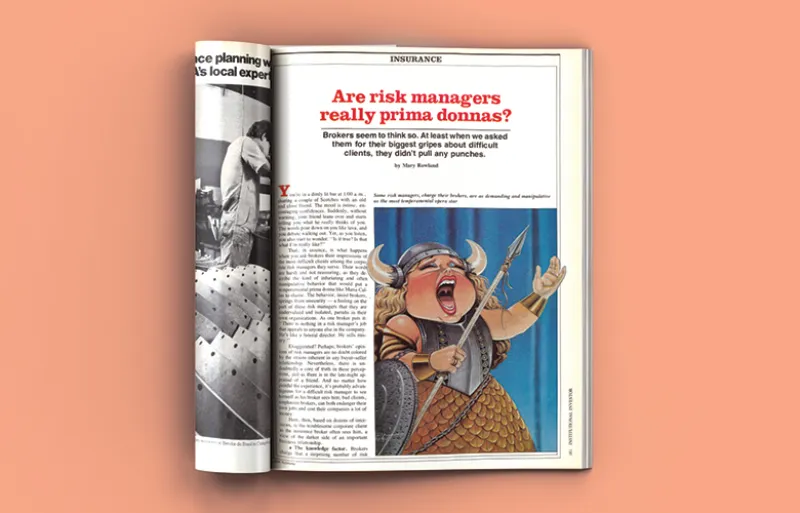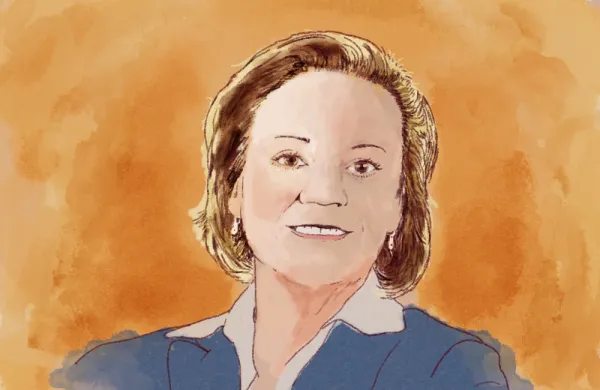If the insurance brokers had called their clients “muppets” — the infamous epithet Goldman Sachs still hasn’t shaken off — that would have been the nicest thing said in the entire article.
For her feature in the April 1983 issue of Institutional Investor — “Are Risk Managers Really Prima Donnas?” — author Mary Rowland conducted dozens of interviews with insurance brokers about their corporate risk manager clients. Offering them anonymity in exchange for candor, even Rowland seems taken aback by the brokers’ contempt for the poorly paid “pariahs” who bought their products. And the cynical grifting seemed to go both ways.
“Brokers complain that some risk managers place far too much emphasis on entertainment perks,” Rowland wrote. “One risk manager and his wife take an expensive two-week vacation every year, paid for by his company’s broker.” When a peer asked how he could justify such an action, he reportedly said, “Management tells me which broker I have to use, so I’m going to get whatever I can.”
Oh boy.
The risk managers were not given five pages of editorial real estate to respond and likewise pick apart their insurance salesmen. But if brokers reported money-grubbing mutual distrust, chances are slim that clients believed they were soul mates. And both would know who had the superior status, paycheck, and expense account. “There are risk managers who simply enjoy being wooed,” Rowland reported, “despite the fact that they don’t have the authority to hire a new broker, even if they wanted to.”
But at the very moment those insurance salesmen were masters of the universe, and risk managers “undervalued and isolated,” the sands were shifting under their feet. Peddling insurance and managing risk have had inverse professional trajectories since then: The death of the salesman coincides with the rise of the actuary. By 1994, II saw a trend of brokers pivoting to consulting, or trying to.
“Brokers aren’t making much money at it yet,” Jan Schut wrote in the March issue. “Consulting in general is something we all have to do to survive, but we’ll have to do a better job of pricing it,” conceded Diane Askwyth, then COO of Willis Corroon Corp., which was later vacuumed up into insurance giant Willis Group. Askwyth escaped her tanking trade and became VP of risk and insurance for Caesars Entertainment in 2010 before retiring in 2013. But the fate of her swaggering anonymous peers quoted in 1983 isn’t knowable. Rowland closed with a warning from one of them to a “risk manager who ‘changes carriers constantly.’”
“When the market tightens up, he thinks about building company loyalty, and then it’s too late,” the broker projected. He wasn’t all wrong. II’s snapshot of this caustic moment in financial relations suggests it was, by then, too late for repairs. A full-blown liability insurance crisis unfolded a year later, sending premiums and insurers’ profits skyward. Providers and clients both pulled out of coverage deals. Corporations, caught blindsided, turned to their peers and formed risk pools, effectively self-covering one another without an insurance company. Many of these mandates never returned, nor did the glory years of insurance brokerage.
“It was a real watershed time for us in the risk management world,” consultant Rick Betterley said in a 2011 interview. Executives began to recognize the function’s value, and that “the insurance industry was a less reliable source of balance sheet protection” than assumed. Finally, Betterley said, “the brokers became significantly more professional following that event.”






